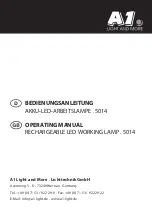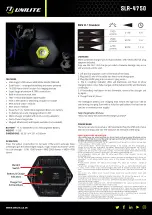
4
ENGLISH
(Original instructions)
b. Do not use the power tool if the switch does not turn it
on and off.
Any power tool that cannot be controlled with
the switch is dangerous and must be repaired.
c. Disconnect the plug from the power source and/or the
battery pack from the power tool before making any
adjustments, changing accessories, or storing power
tools.
Such preventive safety measures reduce the risk of
starting the power tool accidentally.
d. Store idle power tools out of the reach of children and
do not allow persons unfamiliar with the power tool or
these instructions to operate the power tool.
Power
tools are dangerous in the hands of untrained users.
e. Maintain power tools. Check for misalignment or
binding of moving parts, breakage of parts and any
other condition that may affect the power tools
operation. If damaged, have the power tool repaired
before use.
Many accidents are caused by poorly
maintained power tools.
f. Keep cutting tools sharp and clean.
Properly
maintained cutting tools with sharp cutting edges are less
likely to bind and are easier to control.
g. Use the power tool, accessories and tool bits etc. in
accordance with these instructions, taking into
account the working conditions and the work to be
performed.
Use of the power tool for operations
different from those intended could result in a
hazardous situation.
5. Battery tool use and care
a. Recharge only with the charger specified by the
manufacturer.
A charger that is suitable for one type of
battery pack may create a risk of fire when used with
another battery pack.
b. Use power tools only with specifically designated
battery packs.
Use of any other battery packs may create
a risk of injury and fire.
c. When battery pack is not in use, keep it away from
other metal objects, like paper clips, coins, keys,
nails, screws, or other small metal objects, that can
make a connection from one terminal to another.
Shorting the battery terminals together may cause burns
or a fire.
d. Under abusive conditions, liquid may be ejected from
the battery; avoid contact. If contact accidentally
occurs, flush with water. If liquid contacts eyes,
additionally seek medical help.
Liquid ejected from the
battery may cause irritation or burns.
6. Service
a. Have your power tool serviced by a qualified repair
person using only identical replacement parts.
This
will ensure that the safety of the power tool is maintained.
Additional power tool safety warnings
@
Warning!
Additional safety warnings for lights
u
Never attempt to remove or replace any parts other than
those specified in this manual.
u
Do not operate without the lens in place or with a dam-
aged lens.
u
Never look directly into the light or shine the light into
another persons eyes.
u
The luminaire should be positioned so that prolonged
staring into the luminaire at a distance closer than 1.2 m is
not expected
@
Warning! Fire hazard.
Do not operate worklight
or charger near flammable liquids or in gaseous
or explosive atmospheres. Internal sparks may
ignite fumes causing personal injury.
u
Do not expose light or charger to wet or damp areas. Do
not expose light or charger to rain or snow.
u
Do not wash light or charger with water or allow water to
get inside light or charger. Do not submerge light in water at
any time.
@
Caution! When not in use, place tool on its
side on a stable surface where it will not
cause a tripping or falling hazard.
Some tools
with large battery packs will stand upright on the
battery pack but may be easily knocked over.
u
Never view directly with optical instruments into the light
source.
Residual risks.
Additional residual risks may arise when using the tool which
may not be included in the enclosed safety warnings. These
risks can arise from misuse, prolonged use etc.
Even with the application of the relevant safety regulations
and the implementation of safety devices, certain residual
risks can not be avoided. These include:
u
Injuries caused by touching any rotating/moving parts.
u
Injuries caused when changing any parts, blades or ac
-
cessories.
u
Injuries caused by prolonged use of a tool. When using
any tool for prolonged periods ensure you take regular
breaks.
u
Impairment of hearing.
u
Health hazards caused by breathing dust developed when
using your tool (example:- working with wood, especially
oak, beech and MDF.)
Labels on tool
The following pictograms along with the date code are shown
on the tool:


























